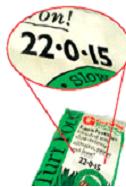Considerations for Fertilizer and Pesticides Use
Use only Phosphorus-Free Fertilizer
The “P” in N-P-K fertilizer labels should be zero!
Don’t use phosphorus fertilizers on your lawns. Phosphorus (P) is a plant nutrient that can feed algal blooms in our lakes and ponds, and can degrade our drinking water. Most lawns, if they need fertilizer, only require nitrogen (N) fertilizer, and do NOT require phosphorus. The three numbers on fertilizer bags show N-P-K nutrients. The middle number is the phosphorus content. Phosphorus-free fertilizer has a “zero” in the middle number. Lawns rarely need extra potassium (K) but it will not be detrimental to the lakes.
Cornell University, in 2004, summarized the results from the 1039 Westchester County soil samples submitted for analysis over a 7-year period. In their summary, they state that these results may be skewed to problem soils because most people do not submit soil tests unless they have a problem. Even so, they find the “majority of tested soils also appear to have adequate amounts of phosphorus to grow different plants including lawns.” (Specifically, no samples tested very low in phosphorus, and 9% tested low, and 34% tested very high.) The report continues: “This is important information because excess phosphorus continues to be a problem in certain bodies of water in Westchester County. One of the manageable sources of this phosphorus is phosphorus-containing fertilizer for lawns. …fertilizers containing phosphorus should not be applied to established lawns unless a soil test report specifically indicates that it is needed.”
Phosphorus-free fertilizer is generally available since NYS regulations prohibit the sale of fertilizer containing phosphorus unless a soil test shows it is needed. Fertilizer of any type should not be applied when heavy rains are expected, when the ground is frozen, or within 20 feet of a lake or stream. All of these can enable more phosphorus to reach the water.
If you use a lawn service, you should insist that they use phosphorus-free fertilizer. You are paying for their service, and you have a right to ensure that they don’t waste your money or degrade the water.
To help keep a healthy lawn, overseed with additional grass seed each fall and spring to help out-compete weeds and to fill in any bare spots. Mow to a height of 3 to 4 inches to help grass tolerate pests and shade out weeds. Leave the grass clippings to recycle the nutrients into the lawn.
Pesticides and Herbicides
It’s difficult to categorize all pesticides and herbicides in one broad sweep, since the different chemicals act in different ways, persist for different periods, and vary in their threat to groundwater and human health. Some herbicides that are commonly used can be especially toxic to plants and animals when used near water. Others can travel rapidly to reach groundwater and lakes. By definition, pesticides and herbicides are designed to affect ecosystems and disrupt growth – but it’s becoming more clear that the long term side effects need further study. If you don’t absolutely need to use them, don’t. If you need to use them, make sure you read and follow the directions. More is not better. Make sure the label clearly states that the product can be used as you intend to use it.
